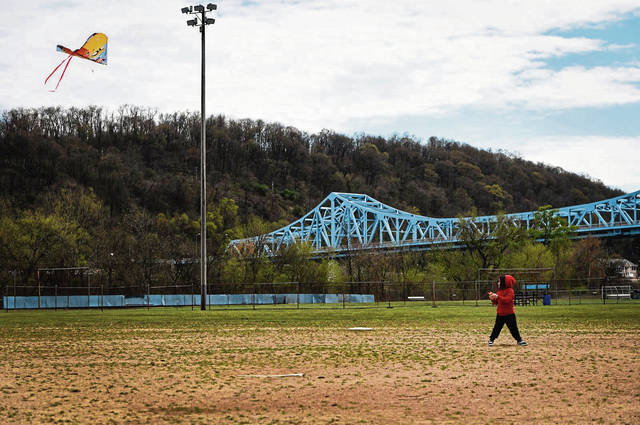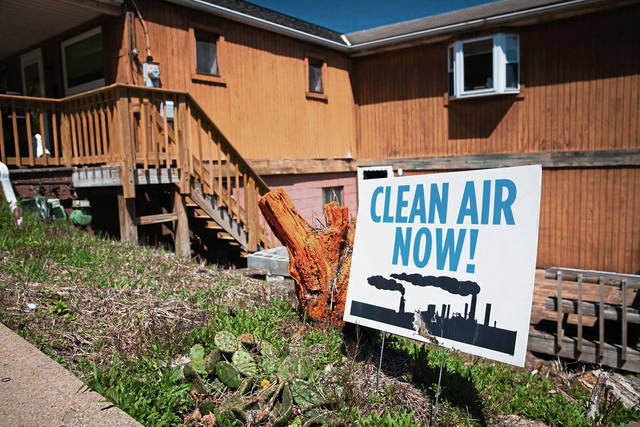Air quality in Western Pa. showed slight improvement in pandemic shutdown
As coronavirus restrictions closed businesses and reduced road traffic during much of March and April, some of the country’s most polluted cities experienced better air quality.
Los Angeles, notorious for its heavy smog, at one point reported the cleanest air among any major city worldwide. By some measures, Washington, D.C., reported its best air quality since 1999. Boston, New York City and Philadelphia also were among the cities that showed significant improvements in air quality similar to what was seen in Italy and China while coronavirus stay-at-home orders were in place.
But the Pittsburgh region — which was ranked among the worst in the nation for air quality by the American Lung Association in April — did not enjoy the same dramatic reprieve, some early analyses showed.
“I was a little surprised that it hasn’t been bigger so far,” Karen Clay, professor of economics and public policy at Carnegie Mellon University’s Heinz College, said of the region’s modest improvement in air quality during recent weeks. Clay recently led a national study of air pollution.
Unlike other cities, car traffic is not the biggest source of air pollution in the Pittsburgh region. Industrial polluters contribute a significant amount of the region’s air pollution, and at least some of those facilities continued to operate throughout March and April.
Coal and steel production were deemed essential under the governor’s business closure order, for example. Other industrial and manufacturing facilities also were allowed to operate, but it’s not clear exactly how many were still open for business and at what capacities they were operating.
A spokesperson for Allegheny Technologies Inc., which operates a hot rolling mill and processing facility in Harrison, was not able to provide information about changes in emissions from ATI facilities during the state’s stay-at-home and business closure orders.
Most ATI facilities in Western Pennsylvania have continued to operate, she said.
U.S. Steel’s Mon Valley Works — which includes the Clairton Coke Works in Clairton, the Edgar Thomson Plant in Braddock and the Irvin Plant in West Mifflin — did not experience significant reductions in operations during that period, a spokesperson told the Tribune-Review in April.
The company later announced it would cut back production by idling blast furnaces in the United States, including one at the Mon Valley Works.
U.S. Steel’s Mon Valley Works have not had a significant reduction in operations, a company spokesperson said.
“While we continue to monitor developments and make production adjustments as needed in line with market conditions, those adjustments have not resulted in significant headcount reductions at our Mon Valley Works,” the U.S. Steel statement said.
“If you live near the parkway, then your air quality probably is a bit better,” Clay said, citing data collected daily from Allegheny County Health Department air quality monitors. “But if you don’t live near the parkway, then the change in car traffic is probably having much less impact.”
More data and in-depth analysis still is needed to understand how much the warmer weather or changes in other sources of pollution might have contributed to those changes in air quality, Clay said.
PennDOT data shows a 50% to 60% drop in traffic on roadways managed by the agency, such as Routes 28 and 51 or Interstates 279 and 376, in recent weeks.
Jim Kelly, Allegheny County’s deputy director of environmental health, said the region is actually experiencing some of the lowest levels of pollution on record for March and April.
This includes pollutants related to traffic such as nitrogen dioxide and carbon monoxide.
Levels of fine particulate matter, or PM 2.5, which also are related to industry and traffic, have shown small but significant decreases when compared to the maximum annual values allowed by federal standards, Kelly said.
“The standard is only 12 micrograms per cubic meter, so a reduction of one or so does not appear like much,” he said. “But every microgram of reduction is nearly 10%. Additionally, this is typically a time of year where we see some of our lowest values, making any additional reduction appear small.”
Local environmental groups shared similar findings but were cautious about drawing conclusions.
The Group Against Smog and Pollution compared data collected from air quality monitors operated by the Allegheny County Health Department from 2017 to 2020. The monitors measure particle pollution, or particulate matter, among other pollutants.
Fine particulate matter can cause health problems because the particles are small enough to pass through the throat and nose and enter the lungs.
Data from 2020 for the time of the closures did show some improvement over the same period for the previous three years, said Ned Mulcahy, staff attorney with GASP.
The governor ordered nonessential businesses to close March 16.
Average daily PM 2.5 levels recorded at county air quality monitors in Avalon and Lawrenceville during the period of business closures this year showed improvements of about 0.12 micrograms per cubic meter and 0.14 micrograms per cubic meter — or about 1% — compared to an average calculated using data from 2017 through 2019 for the same time period, according to figures compiled by GASP.
PM 2.5 readings from the Parkway East monitor improved by 0.66 micrograms per cubic meter, or about 7%. Readings from the Liberty monitor, near the Clairton Coke Works, improved by about 2.4 micrograms per cubic meter, or about 20%.
While this points to some improvement in air quality, it’s difficult to know for sure, Mulcahy said. Air quality is generally better in spring than in winter months, when the region experiences temperature inversions that trap pollution close to the ground.
From Jan. 1 to March 19 — when Gov. Tom Wolf ordered non-life-sustaining businesses to close — 42% of the days had bad air quality, said Matt Mehalik, executive director of the Breathe Project, citing data from the federal Environmental Protection Agency Air Quality Index.
The Air Quality Index measures five major pollutants, including ground-level ozone, carbon monoxide, sulfur dioxide, nitrogen dioxide and particle pollution.
From March 19 to April 21, there were fewer bad air quality days compared to previous weeks — about 25% of days had bad air quality, Mehalik said. The improvement was likely because of less traffic and general cutbacks among businesses and industry. But there also were at least four days when air quality spiked to unhealthy levels that could be harmful to sensitive groups, he said.
North Braddock resident Edith Abeyta, who lives about a half-mile from the U.S. Steel Edgar Thomson Plant, said she didn’t notice changes in air quality during the period of the stay-at-home order.
“Eye and nose irritation, throat irritation, that all of a sudden happens inexplicably,” she said, describing the conditions she lives with in general. “All of a sudden, your eyes are watering, your nose is irritated.”
Jamie Martines is a Tribune-Review staff writer. You can contact Jamie by email at jmartines@triblive.com or via Twitter .
Remove the ads from your TribLIVE reading experience but still support the journalists who create the content with TribLIVE Ad-Free.










